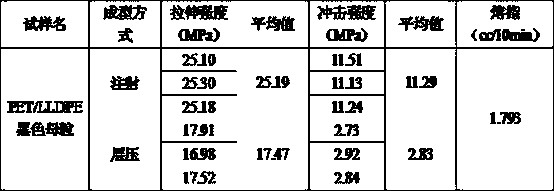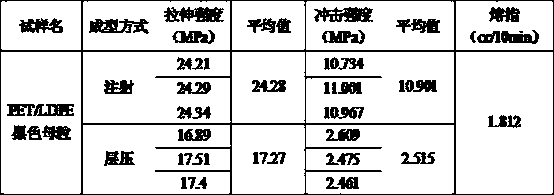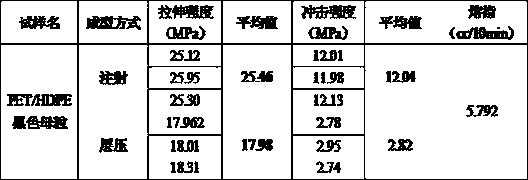Method for processing PET/PA ferrous alloy color masterbatch by chemically depolymerizing waste polyester textiles
A technology for waste textiles and color masterbatches, applied in the direction of plastic recycling, recycling technology, etc., can solve problems such as inability to directly reprocess, waste of land resources, secondary pollution, landfill or incineration, etc.
- Summary
- Abstract
- Description
- Claims
- Application Information
AI Technical Summary
Problems solved by technology
Method used
Image
Examples
Embodiment 1
[0009] A kind of chemical depolymerization of polyester waste and old textiles according to the present invention, the method for processing PET / PE black alloy color masterbatch is implemented according to the following process procedures:
[0010] Depolymerize polyester waste textiles with glycerin residue heated to 260-280 degrees, and filter the dregs in the solution to obtain liquid PET. Prepare PET / LDPE blown film type black masterbatch according to the following parts by weight.
[0011] PET 20 copies
[0012] Blown film grade LDPE 40 parts
[0013] Black carbon black 30 parts
[0014] Compatibilizer 10 parts
[0015] Test results
[0016]
[0017] Mix the above prepared components and parts by weight, extrude and granulate, and obtain PET and LDPE black alloy blown film type
[0018] Masterbatch.
Embodiment 2
[0020] With reference to the method of Example 1, the PET / LLDPE extruded black masterbatch was prepared with each component and parts by weight in the following proportions.
[0021] PET 30 parts
[0022] Extrusion grade LLDPE 30 parts
[0023] Black carbon black 30 parts
[0024] Compatibilizer 10 parts
[0025] Test results
[0026]
[0027] Mix the above prepared components and parts by weight, extrude and granulate to obtain PET and LLDPE black alloy extrusion-type color masterbatch.
Embodiment 3
[0029] With reference to Examples 1 and 2, the PET / HDPE injection molding black masterbatch was prepared with each component and parts by weight in the following proportions.
[0030] PET 40 copies
[0031] Injection molding grade HDPE 20 parts
[0032] Black carbon black 30 parts
[0033] Compatibilizer 10 parts
[0034] Test results
[0035]
[0036] Mix the above prepared components and parts by weight, extrude and granulate to obtain PET and HDPE black alloy injection molding color masterbatch.
PUM
 Login to View More
Login to View More Abstract
Description
Claims
Application Information
 Login to View More
Login to View More - R&D
- Intellectual Property
- Life Sciences
- Materials
- Tech Scout
- Unparalleled Data Quality
- Higher Quality Content
- 60% Fewer Hallucinations
Browse by: Latest US Patents, China's latest patents, Technical Efficacy Thesaurus, Application Domain, Technology Topic, Popular Technical Reports.
© 2025 PatSnap. All rights reserved.Legal|Privacy policy|Modern Slavery Act Transparency Statement|Sitemap|About US| Contact US: help@patsnap.com



